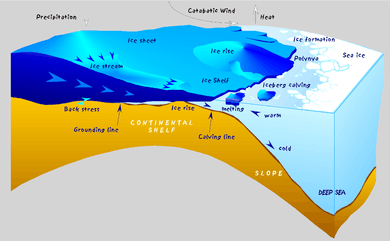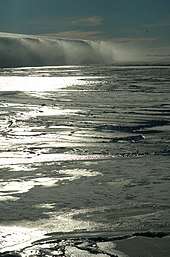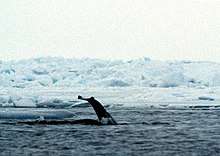Polynya
A polynya (/pəˈlɪnjə/) is an area of open water surrounded by sea ice.[1] It is now used as a geographical term for an area of unfrozen seawater within otherwise contiguous pack ice or fast ice. It is a loanword from the Russian полынья (Russian pronunciation: [pəɫɨˈnʲja]), which refers to a natural ice hole and was adopted in the 19th century by polar explorers to describe navigable portions of the sea.[2][3]


.jpg)
There are two main types of polynyas: coastal polynyas, which can be found year-round near the Antarctic and Arctic coasts and are mainly created by strong winds pushing the ice away from the coast, and mid-sea or open-ocean polynyas, which may be found more sporadically in the middle of ice pack in certain locations, especially around Antarctica. These locations are generally preconditioned by certain oceanic dynamics.
One of the most famous mid-sea polynyas is the Weddell Polynya or the Maud Rise Polynya, which occurs in the Lazarev Sea over the Maud Rise seamount. It was first spotted in September 1973 and persisted through multiple winters (1974–1976), and recently recurred in September 2017.[4][12]
Formation
Coastal polynyas are formed through two main processes:
- A sensible heat polynya is thermodynamically driven, and typically occurs when warm water upwelling keeps the surface water temperature at or above the freezing point. This reduces ice production and may stop it altogether.
- A latent heat polynya is formed through the action of katabatic winds, which act to drive ice away from a fixed boundary such as a coastline, fast ice, or an ice bridge. The polynya forms initially when first-year pack ice is driven away from the coast, which leaves an area of open water within which new ice is formed. This new ice is then also herded downwind toward the first-year pack ice. When it reaches the pack ice, the new ice is consolidated onto the pack ice. This process continues over time. Latent heat polynyas are therefore a major source of sea ice production in the Antarctic.[5]
Latent heat polynyas are regions of high ice production and therefore are possible sites of dense water production in both polar regions. The high ice production rates within these polynyas leads to a large amount of brine rejection into the surface waters; this salty water then sinks. It is an open question as to whether the polynyas of the Arctic can produce enough dense water to form a major portion of the dense water required to drive the thermohaline circulation.
Mid-sea polynyas are formed when specific atmospheric conditions occur over preconditioned oceanographic areas. Such atmospheric conditions should favor ice drift in opposite directions to open the ice pack. Polar cyclones are a typical atmospheric trigger for the occurrence of mid-sea polynyas as the cyclonic winds push the ice in opposite directions away from the cyclone center.[6] Also, cold fronts, where two opposite flows in direction are found, are ideal for creating a mid-sea polynya.

Antarctic Bottom Water (AABW)
Antarctic Bottom Water is the dense water with high salinity that exists in the abyssal layer of the Southern Ocean. It plays a major role in the global overturning circulation.[7] Coastal polynyas (latent heat polynyas) are a source of AABW as brine rejection during the formation of sea ice at these polynyas increases the salinity of the seawater, which then sinks down to the ocean bottom as AABW.[8][9] Antarctic polynyas form when ice masses diverge from the coast and move away in the direction of the wind, creating an exposed area of sea water which subsequently freezes over, with brine rejection, to form another mass of ice.[10]
Ecology
Some polynyas, such as the North Water Polynya between Canada and Greenland, occur seasonally at the same time and place each year. Because animals can adapt their life strategies to this regularity, these types of polynyas are of special ecological research significance. In winter, marine mammals such as walruses, narwhals, and belugas that do not migrate south remain there. In spring, the thin or absent ice cover allows light to penetrate the surface layer as soon as the winter night ends, which triggers the early blooming of microalgae at the basis of the marine food chain. Thus polynyas are suspected to be places where intense and early production of planktonic herbivores ensures the transfer of solar energy fixed by planktonic microalgae to Arctic cod, seals, whales, and polar bears. Polar bears are known to be able to swim as far as 65 kilometres (40 mi) across open waters of a polynya.[11]
The presence of polynyas in McMurdo Sound in the Antarctic provides an ice-free area where penguins can feed, and therefore they are important for the survival of the Cape Royds penguin colony.[12]
Arctic navigation
When submarines of the U.S. Navy made expeditions to the North Pole in the 1950s and 1960s, there was significant concern about surfacing through the thick pack ice of the Arctic Ocean. In 1962, both the USS Skate and USS Seadragon surfaced within the same large polynya near the North Pole for the first polar rendezvous of the U.S. Atlantic Fleet and the U.S. Pacific Fleet.[13]
References
- W.J. Stringer and J.E. Groves. 1991. Extent of Polynyas in the Bering and Chukchi Seas
- Sherard Osborn, Peter Wells and A. Petermann. 1866. Proceedings of the Royal Geographical Society of Australia, Vol 12 no 2 1867–1868 pp 92–113 On the Exploration of the North Polar Region
- polynya, Merriam Webster Dictionary
- Weddell Polynya, NASA, 1999
- Skogseth, R.; Haugan, P. M.; Haarpaintner, J. (2004-10-01). "Ice and brine production in Storfjorden from four winters of satellite and in situ observations and modeling". Journal of Geophysical Research: Oceans. 109 (C10): C10008. Bibcode:2004JGRC..10910008S. doi:10.1029/2004jc002384. ISSN 2156-2202.
- Francis, Diana; Eayrs, Clare; Cuesta, Juan; Holland, David (24 April 2019). "Polar Cyclones at the Origin of the Reoccurrence of the Maud Rise Polynya in Austral Winter 2017". Journal of Geophysical Research: Atmospheres. 124 (10): 5251–5267. Bibcode:2019JGRD..124.5251F. doi:10.1029/2019JD030618.
- Johnson, Gregory C. (2008-05-01). "Quantifying Antarctic Bottom Water and North Atlantic Deep Water volumes". Journal of Geophysical Research: Oceans. 113 (C5): C05027. Bibcode:2008JGRC..113.5027J. doi:10.1029/2007jc004477. ISSN 2156-2202.
- Tamura, Takeshi; Ohshima, Kay I.; Nihashi, Sohey (2008-04-01). "Mapping of sea ice production for Antarctic coastal polynyas". Geophysical Research Letters. 35 (7): L07606. Bibcode:2008GeoRL..35.7606T. doi:10.1029/2007gl032903. ISSN 1944-8007.
- Ohshima, Kay I.; Fukamachi, Yasushi; Williams, Guy D.; Nihashi, Sohey; Roquet, Fabien; Kitade, Yujiro; Tamura, Takeshi; Hirano, Daisuke; Herraiz-Borreguero, Laura (2013). "Antarctic Bottom Water production by intense sea-ice formation in the Cape Darnley polynya". Nature Geoscience. 6 (3): 235–240. Bibcode:2013NatGe...6..235O. doi:10.1038/ngeo1738.
- Ohshima, Kay I.; Fukamachi, Yasushi; Williams, Guy D.; Nihashi, Sohey; Roquet, Fabien; Kitade, Yujiro; Tamura, Takeshi; Hirano, Daisuke; Herraiz-Borreguero, Laura (2013). "Antarctic Bottom Water production by intense sea-ice formation in the Cape Darnley polynya". Nature Geoscience. 6 (3): 235–240. Bibcode:2013NatGe...6..235O. doi:10.1038/ngeo1738.
- C. Michael Hogan. 2008 Polar Bear: Ursus maritimus, Globaltwitcher.com, ed. N. Stromberg Archived 2008-12-24 at the Wayback Machine
- "Penguins in high latitudes". NZETC. 12 June 2014.
- Tales of a Cold War Submariner by Dan Summitt, 2004.
External links
- Polar cyclones at the origin of the reoccurrence of the Maud Rise Polynya in austral winter 2017 (NOW) at agupubs.onlinelibrary.wiley.com [Error: unknown archive URL] (archived 24 April 2019)
- International North Water Polynya Study (NOW) at the Wayback Machine (archived 11 February 2009)
- Polynya north of Alaska at NASA Earth Observatory